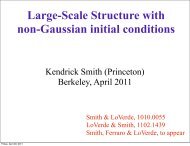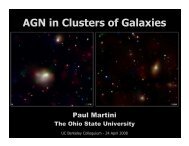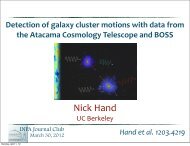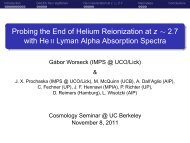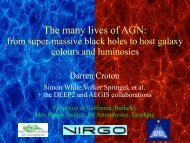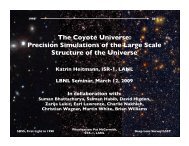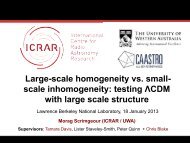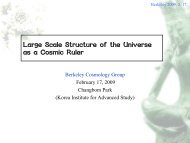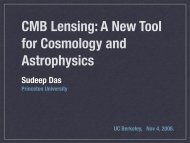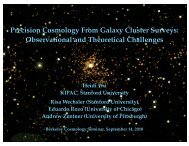Probing Dark Energy and Dark Matter with Distant Galaxies from ...
Probing Dark Energy and Dark Matter with Distant Galaxies from ...
Probing Dark Energy and Dark Matter with Distant Galaxies from ...
Create successful ePaper yourself
Turn your PDF publications into a flip-book with our unique Google optimized e-Paper software.
<strong>Probing</strong> <strong>Dark</strong> <strong>Energy</strong> <strong>and</strong> <strong>Dark</strong> <strong>Matter</strong><br />
<strong>with</strong> <strong>Distant</strong> <strong>Galaxies</strong> <strong>from</strong><br />
HETDEX <strong>and</strong> LSST<br />
Eric Gawiser<br />
Rutgers University<br />
MUSYC UBR image
A St<strong>and</strong>ard Model of<br />
Cosmology: ΛCDM<br />
Age of universe: 13.8 Gyr<br />
Average curvature: flat (Ω total=1.00)<br />
<strong>Dark</strong> <strong>Energy</strong>: 74% (Ω DE =0.74)<br />
<strong>Dark</strong> <strong>Matter</strong>: 22% (Ω DM =0.22)<br />
Baryons: 4% (Ω B =0.04)<br />
Primordial power spectrum: n=0.95<br />
(consistent <strong>with</strong> inflation)
Motivation<br />
"A revolution in our underst<strong>and</strong>ing of fundamental<br />
physics will be required to achieve a full underst<strong>and</strong>ing<br />
of the cosmic acceleration."<br />
(<strong>Dark</strong> <strong>Energy</strong> Task Force, Albrecht et al. 2006)
Coming Attractions:<br />
A Tale of Three Collaborations<br />
Overview of Cosmological Principle <strong>and</strong> Cosmological Structure Formation<br />
<strong>Dark</strong> <strong>Matter</strong> "Halo" Masses of Lyman Alpha Emitting <strong>Galaxies</strong> <strong>from</strong> MUSYC<br />
-Show that their present-day descendants are typical galaxies like the Milky Way<br />
-Enable these galaxies to be used for future experiments<br />
Near-future Studies Using Lyman Alpha Emitting <strong>Galaxies</strong> found by HETDEX<br />
-Probe dark energy using Baryon Acoustic Oscillations as a "st<strong>and</strong>ard rod"<br />
-Measure curvature <strong>and</strong> dark matter properties (including neutrino masses)<br />
Future Studies Using High-redshift <strong>Galaxies</strong> found by LSST<br />
-Measure dark energy properties as a function of time<br />
-Test the Cosmological Principle
The Cosmological Principle<br />
On large scales, the Universe looks<br />
statistically the same at all locations<br />
(homogeneity) <strong>and</strong> in all directions (isotropy).
Cosmic Microwave Background anisotropy, Large-scale structure
Cosmic Microwave Background anisotropy, Large-scale structure<br />
both show baryon acoustic oscillations<br />
SDSS-DR5<br />
Percival et al. 2007
Galaxy Power Spectrum P(k) offers 5 measures to exploit:<br />
1. Baryon Acoustic Oscillation (BAO) st<strong>and</strong>ard rod: geometry<br />
2. Amplitude of oscillations: structure growth<br />
3. Amplitude of galaxy P(k): structure growth<br />
4. Linear/non-linear transition: geometry, structure growth<br />
5. General shape (e.g., turn-over, slope, cutoff): dark matter
€<br />
H 2 = ˙ ⎛⎛ a<br />
⎜⎜<br />
⎝⎝ a<br />
⎞⎞<br />
2<br />
⎟⎟<br />
⎠⎠<br />
˙ ˙<br />
a<br />
a<br />
The Friedmann Equations<br />
= −4πG<br />
3<br />
= 8πGρ<br />
−<br />
3<br />
k<br />
a 2<br />
c ≡1,k → 0<br />
( )<br />
( ρ + 3p)<br />
= −4πGρ<br />
( 1+ 3w ) eff p ≡ wρ<br />
3<br />
p = − dE<br />
dV = − d(ρa3 )<br />
d(a 3 )<br />
⎯⎯ → ρ ∝ a−3(1+w)<br />
( )
Expansion History of the Universe<br />
λ obs/λ rest = a 0/a = (1+z)<br />
H 2 (z)=H 0 2 {Ωm(1+z) 3 +Ω DEexp(3∫(1+w(z))/(1+z) dz)}<br />
(w is the equation-of-state of dark energy, p = w ρ)<br />
r(z) = c ∫dz/H(z)<br />
Baryon acoustic oscillation fundamental mode gives scale R s<br />
Measured radial scale Δz probes H(z)=c Δz /R s <strong>and</strong><br />
transverse angular scale Δθ probes r(z)=R s/Δθ
MUSYC (Multiwavelength Survey by Yale-Chile)<br />
Eric Gawiser (Rutgers, P.I.)<br />
Pieter van Dokkum (Yale)<br />
Paulina Lira (U. Chile)<br />
Meg Urry (Yale)<br />
Viviana Acquaviva (Rutgers)<br />
Michael Berry (Rutgers)<br />
Nicholas Bond (NASA GSFC)<br />
Carie Cardamone (MIT)<br />
Robin Ciardullo (Penn State)<br />
John Feldmeier (Youngstown State)<br />
Harold Francke (P.U. Católica)<br />
Marijn Franx (Leiden)<br />
Lucia Guaita (Stockholm)<br />
Caryl Gronwall (Penn State)<br />
Minh Huynh (Western Australia)<br />
Leopoldo Infante (P.U. Católica)<br />
Sheila Kannappan (UNC)<br />
Sugata Kaviraj (Imperial College)<br />
Mariska Kriek (Harvard-‐CfA)<br />
Peter Kurczynski (Rutgers)<br />
Danilo Marchesini (Tuas)<br />
Ana Matkovic (Penn State)<br />
Nelson Padilla (P.U. Católica)<br />
Ryan Quadri (OCIW)<br />
Kevin Schawinski (Yale)<br />
Ezequiel Treister (Hawaii)<br />
Carlos Vargas (Rutgers)<br />
Jean Walker Soler (Rutgers)<br />
Public Data Release <strong>and</strong> 60 Refereed<br />
Publications available at:<br />
h0p://physics.rutgers.edu/~gawiser/MUSYC<br />
(see also Gawiser et al 2006a, ApJS 162, 1)
Where did we obtain the data?<br />
CTIO4m<br />
+MOSAIC<br />
Found LAE<br />
galaxies in<br />
narrow-b<strong>and</strong><br />
images<br />
Spitzer<br />
+IRAC<br />
Measured<br />
stellar mass<br />
(number of stars)<br />
in LAE galaxies<br />
LAE = Lyman Alpha Emitting<br />
Magellan<br />
+IMACS<br />
Confirmed<br />
LAE redshifts,<br />
purity of sample<br />
HST<br />
+ACS<br />
Determined<br />
sizes of LAE<br />
galaxies <strong>from</strong><br />
archival images
4m Telescope at CTIO
4m Telescope at CTIO
4m Telescope at CTIO
Sloan Digital Sky Survey MUSYC (100X better sensitivity)
75% of the baryons are hydrogen<br />
• At z=3, Lyman series falls in observed-frame optical<br />
• Ly α photons (10.2eV=1216Å) <strong>from</strong> recombination are visible<br />
• Ionizing photons (>13.6eV=912Å) are absorbed → "Lyman break"
Lyman α Emitting (LAE) Galaxy<br />
B NB5000 V
LAE clustering at z=3 in MUSYC-ECDFS<br />
Gawiser et al 2007, Astrophysical Journal 671, 278
w gg(θ) is a projection of ξ gg(r ) via<br />
w gg(θ) = ∫dz 1 ∫dz 2 p(z 1)p(z 2) ξ gg(r(z 1,z 2,θ ))<br />
We invert this projection to turn observed<br />
w gg (θ) into inferred ξ gg (r )
ξ gg( r ) = b g 2 ξDM( r )<br />
Since ξ DM( r ) is well predicted by our st<strong>and</strong>ard<br />
model of cosmology, we can now solve for b g ,<br />
the "bias" factor that determines typical dark<br />
matter halo masses of these galaxies<br />
Method for auto-correlation <strong>from</strong> Mo & White (1996,<br />
MNRAS 282, 347)<br />
First applied to cross-correlation by Gawiser et al (2001,<br />
ApJ 562, 628)
Clustering of 162 LAEs at z=3 in MUSYC-ECDFS<br />
Gawiser et al 2007, Astrophysical Journal 671, 278
Clustering of 250 LAEs at z=2 in MUSYC-ECDFS<br />
r 0 =4.6±0.9 Mpc<br />
b=1.8±0.5<br />
log(M med /M )=11.4±0.5<br />
Guaita et al 2010, Astrophysical Journal 714, 255
Evolution of clustering bias (versus dark matter,<br />
dashed tracks are median of conditional mass function)
Lyman Alpha Emitting galaxies are the smallest distant<br />
galaxies yet studied (half-light radii of 0.5-2 kpc)<br />
(Bond et al 2009 ApJ 705, 639)<br />
2"x2" HST-ACS (GOODS-S)<br />
→<br />
Name that spiral…
MUSYC Results on<br />
Lyman Alpha Emitting <strong>Galaxies</strong><br />
LAE stellar masses are small,
University of Texas:<br />
Josh Adams<br />
Guillermo Blanc<br />
Mark Cornell<br />
Taylor Chonis<br />
Karl Gebhardt (PS)<br />
Lei Hao<br />
Gary Hill (PI)<br />
Donghui Joeng<br />
Eiichiro Komatsu<br />
Hanshin Lee<br />
Phillip MacQueen<br />
Jeremy Murphy<br />
Marc Rafal (PM)<br />
Masatoshi Shoji<br />
AIP:<br />
Andreas Kelz<br />
Volker Mueller<br />
Mardn Roth<br />
Mathias Steinmetz<br />
Lutz Wisotzki<br />
MPE/USM:<br />
Ralf Bender<br />
Niv Drory<br />
Ulrich Hopp<br />
Ralf Koehler<br />
Helena Relke<br />
Jochen Weller<br />
Texas A&M:<br />
Darren DePoy<br />
Steven Finkelstein<br />
Jennifer Marshall<br />
Nicolas Suntzeff<br />
LCO:<br />
Povilas Palunas<br />
Penn State University:<br />
Robin Ciardullo<br />
Caryl Gronwall<br />
Larry Ramsey<br />
Don Schneider<br />
Rutgers:<br />
Eric Gawiser<br />
Viviana Acquaviva
HET<br />
Mt. Fowlkes west Texas<br />
HET is the world’s fourth largest telescope. It will be upgraded<br />
<strong>with</strong> a powerful new instrument consisting of 150 units,<br />
VIRUS (Visible Integral-field Replicable Unit Spectrograph)
INTEGRAL FIELD SPECTROSCOPY<br />
The active galaxy NGC1068, imaged using an Integral Field Unit<br />
Image: Stephen Todd, ROE <strong>and</strong> Douglas Pierce-Price, JAC.
HETDEX will provide:<br />
→ curvature measure to about 0.1% (>10x better than present)<br />
→ H(z=2.5) to 1%<br />
→ D(z=2.5) to 1%<br />
→ modest improvement on dark energy today (w 0)<br />
→ significant improvement on dark energy evolution (w a)<br />
→ amplitude of power spectrum to 1.5% (structure growth)<br />
→ sum of neutrino masses to 0.05eV precision - detection<br />
expected!
Viviana Acquaviva & E.G. 2010, PRD 082001<br />
In the concordance GR+ ΛCDM model:<br />
- Rates of expansion of the universe <strong>and</strong> cosmological structure<br />
growth are exactly predicted <strong>from</strong> one another<br />
ΛCDM<br />
- Structure growth is independent of scale<br />
- Neither statement is true for general dark energy or modified<br />
gravity models, <strong>and</strong> we lack a fundamental theory for those<br />
extensions<br />
- So we should falsify GR+ ΛCDM before exploring illconstrained<br />
parameter spaces for dark energy & modified gravity
The Large Synoptic Survey Telescope (LSST)<br />
TIMELINE: 2018-2028 PRICETAG:$460M<br />
Director: Tony Tyson
The LSST Large-Scale Structure Science Collaboration<br />
Alex<strong>and</strong>ra Abate (LAL, Orsay)<br />
Viviana Acquaviva (Rutgers)<br />
Steve Allen (Stanford)<br />
Mark Allen (Stanford)<br />
Reza Ansari (LAL, Orsay)<br />
Eric Aubourg (Laboratoire APC)<br />
Wayne Barkhouse (North Dakota)<br />
Aurelien Barrau (LPSC Grenoble)<br />
James Bartlett (U. Paris, APC)<br />
Andreas Berlind (V<strong>and</strong>erbilt)<br />
Nicholas Bond (NASA GSFC)<br />
Robert Brunner (Illinois)<br />
Tamas Budavari (JHU)<br />
Luis Campusano (U. Chile)<br />
Asantha Cooray (UC Irvine)<br />
Laurent Derome (LPSC)<br />
Eric Gawiser (Rutgers, Co-Chair)<br />
Brian Gerke (Stanford)<br />
Salman Habib (LANL)<br />
Andrew Hamilton (Colorado)<br />
Jean-Christopher Hamilton (APC)<br />
Alan Heavens (Edinburgh)<br />
Katrina Heitmann (LANL)<br />
Jack Hughes (Rutgers)<br />
Leopoldo Infante (PU Catolica)<br />
Benjamin Koester (U. Chicago)<br />
Lori Lubin (UC Davis)<br />
Felipe Menanteau (Rutgers)<br />
Chris Miller (Michigan)<br />
Joe Mohr (LMU Munich)<br />
Marc Moniez (LAL, Orsay)<br />
Jeffrey Newman (Pittsburgh)<br />
Nelson Padilla (PU Catolica)<br />
Tom Quinn (U. Washington)<br />
Paul Ricker (Illinois)<br />
Eduardo Rozo (U. Chicago)<br />
Ryan Scranton (Google)<br />
Anze Slosar (BNL)<br />
Alex Szalay (JHU)<br />
Jon Thaler (Illinois)<br />
Tony Tyson (UC Davis)<br />
Licia Verde (Barcelona)<br />
Ben W<strong>and</strong>elt (Illinois)<br />
Risa Wechsler (Stanford)<br />
David Wittman(UC Davis)<br />
Idit Zehavi (Case Western)<br />
Hu Zhan (NAO CAS, Co-Chair)<br />
Zheng Zheng (Yale)
LSST will study <strong>Dark</strong> <strong>Energy</strong><br />
<strong>with</strong> 1 billion distant galaxies<br />
Survey covers 20,000 square degrees<br />
(half the sky)<br />
Baryon Acoustic Oscillations via angular<br />
clustering will determine distances to 1%,<br />
which measures dark energy equation-ofstate<br />
to 5% (δw = 0.05)<br />
Blake & Bridle 2005, Seo & Eisenstein 2003<br />
Compare <strong>with</strong> other techniques (weak<br />
lensing, Type Ia supernovae <strong>from</strong> LSST) to<br />
see evolution in w (a.k.a. w a)<br />
P(k)/P smooth (k)<br />
z=3<br />
z=0.3 z=0.8z=1.6<br />
k (h Mpc -1 )
LSST Baryon Acoustic Oscillations (BAO) will<br />
measure distances to
<strong>Dark</strong> <strong>Energy</strong> constraints <strong>from</strong><br />
Weak Lensing + Baryon Acoustic Oscillations<br />
LSST Science Book Fig.15.1
Testing the Cosmological Principle:<br />
Check for inhomogeneities in behavior of<br />
dark energy/modified gravity by comparing<br />
expansion rate <strong>and</strong> structure growth along<br />
multiple lines of sight<br />
(See LSST Science Book Fig.15.12)
Large-scale structure<br />
constraints on cosmological<br />
neutrinos<br />
• Relativistic neutrinos suppress density fluctuations up<br />
to free-streaming length of 1.2 Gpc*(eV/m ν)<br />
• P(k) constrains sum of neutrino masses M ν via<br />
Ω ν =M ν /(94 eV h 2 ), assuming no sterile neutrinos, no<br />
neutrino degeneracy, thermal energy spectra<br />
• LSST will measure sum of neutrino masses to 0.02<br />
eV precision – detection (nearly) guaranteed!<br />
(Song & Knox 2003)
Conclusions<br />
• Observations of distant galaxies offer constraints on dark matter<br />
properties <strong>and</strong> the dark energy equation-of-state (w)<br />
•<br />
• Control of systematics is critical; MUSYC results show that we<br />
can select pure samples of these galaxies <strong>and</strong> use them to<br />
measure large-scale structure<br />
• Future constraints <strong>from</strong> HETDEX <strong>and</strong> LSST using high-redshift<br />
galaxies, weak gravitational lensing <strong>and</strong> Type Ia supernovae will<br />
distinguish between dark energy <strong>and</strong> modified gravity, constrain<br />
w to 5%, <strong>and</strong> measure the sum of neutrino masses to a<br />
precision of 0.02eV




